
上面这种写法是有问题的
redis设置分布式锁 同时设置超时时间 不能分开写 原子操作才行 ,否则 挂掉会有问题
就是说第一行设置完分布式锁的key,第二行设置超时时间的,那么如果在第一行和第二行之间服务器挂掉了就会有问题。
下图这种设置超时时间也是有问题的:
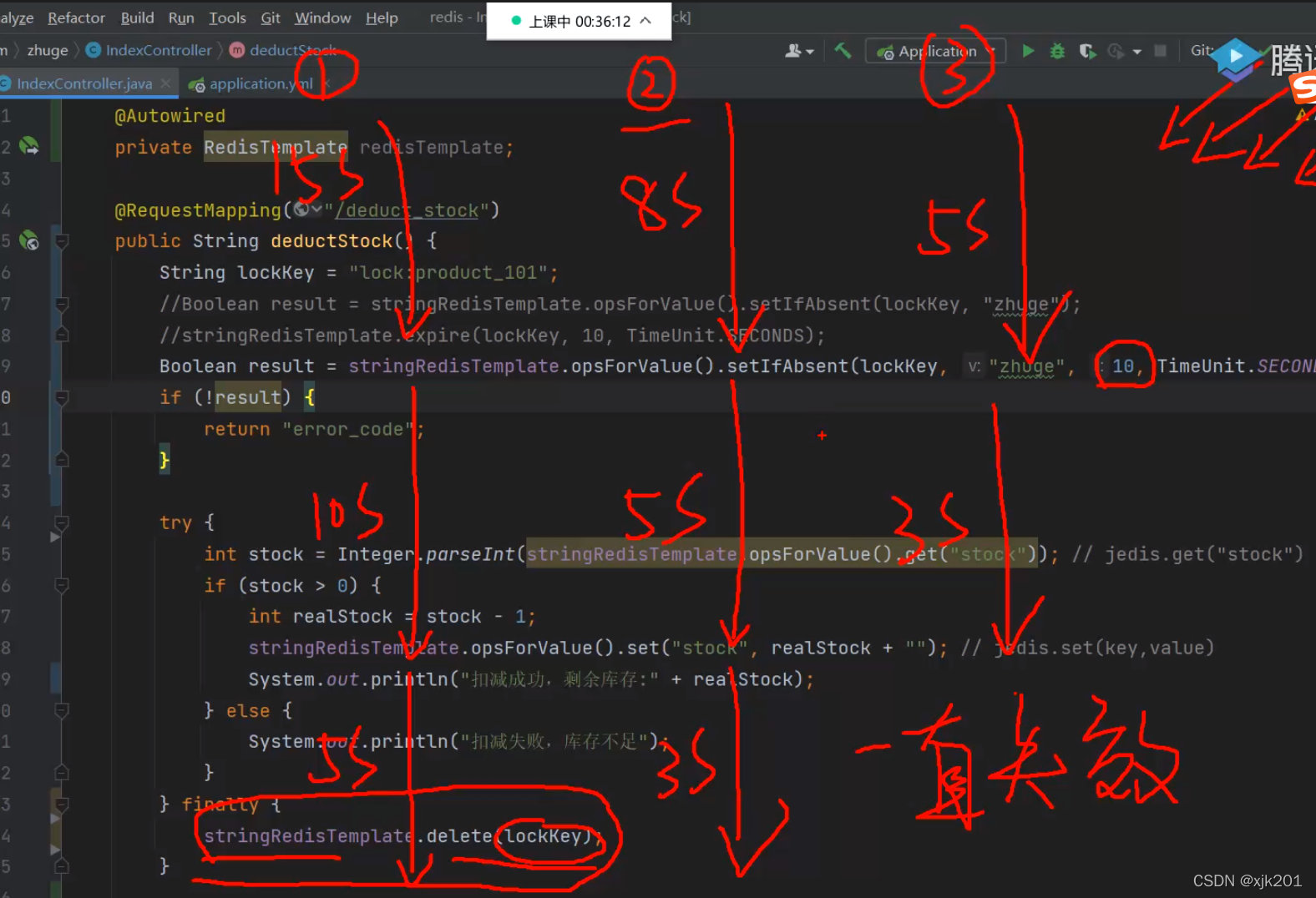
因为是固定的十秒钟,那么存在这种情况:
1.线程一运行了15秒钟,但是锁设置的是十秒钟,那么这时候线程二在线程一运行代码的时候同时加锁运行了,然后线程一在线程二运行五秒钟的时候(也就是线程一的第15秒把锁删除了,这时候线程三就可以直接加锁了)
解决方法:加锁添加当前线程id和客户端id 优化如下:
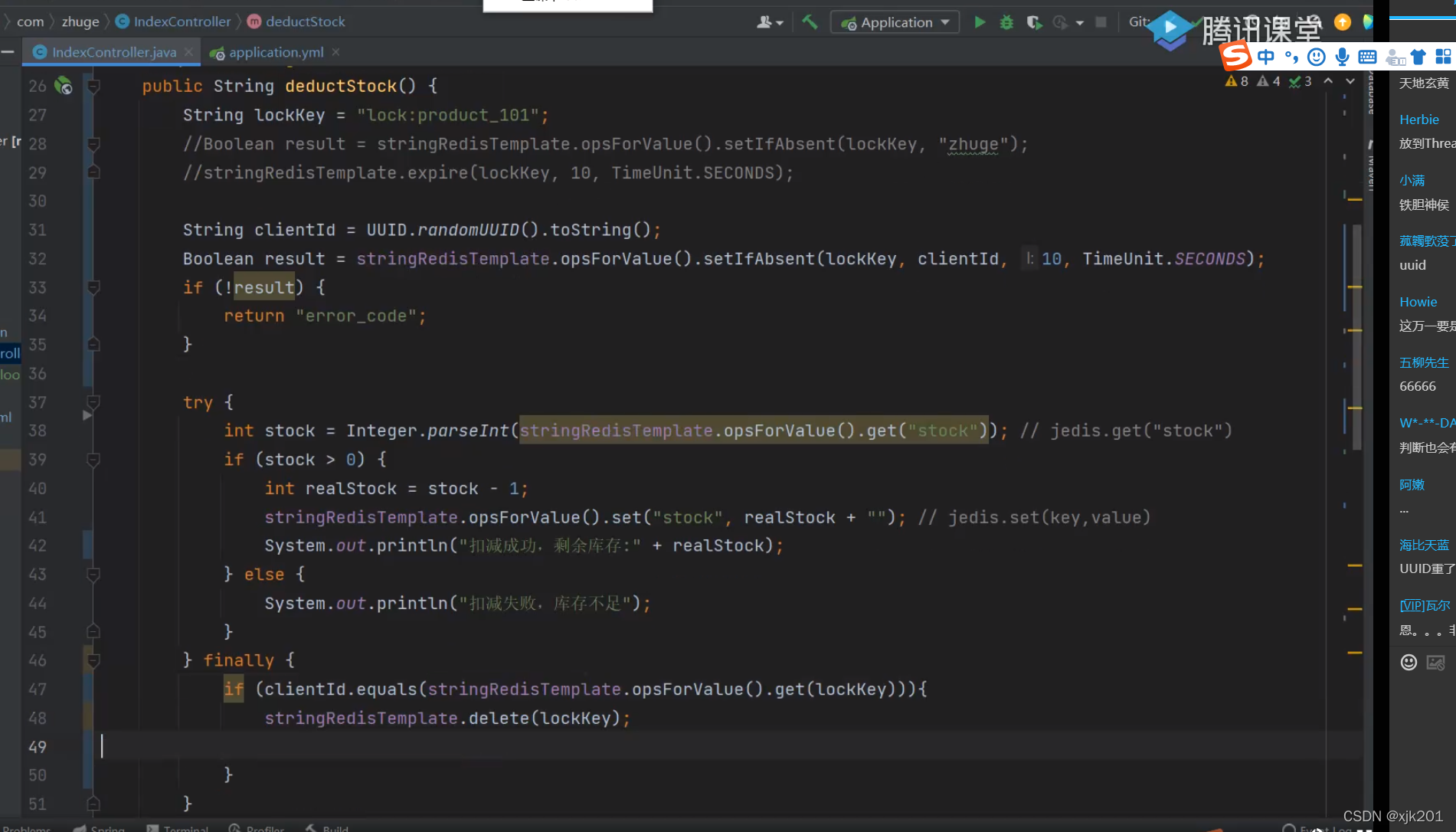
但是这个代码还有个问题:

原子性问题:
线程一9.9秒(无限接近于10秒钟的时候)执行到上图finally的if 执行完,还没有删除锁,但是if执行完了是true ,这时候正好到了十秒钟锁失效线程二直接加锁成功,那么这时候线程一删除锁的话是删除了线程二的锁。
这种要使用锁续命来解决,也就是下面要说的redisson
redission加锁核心: 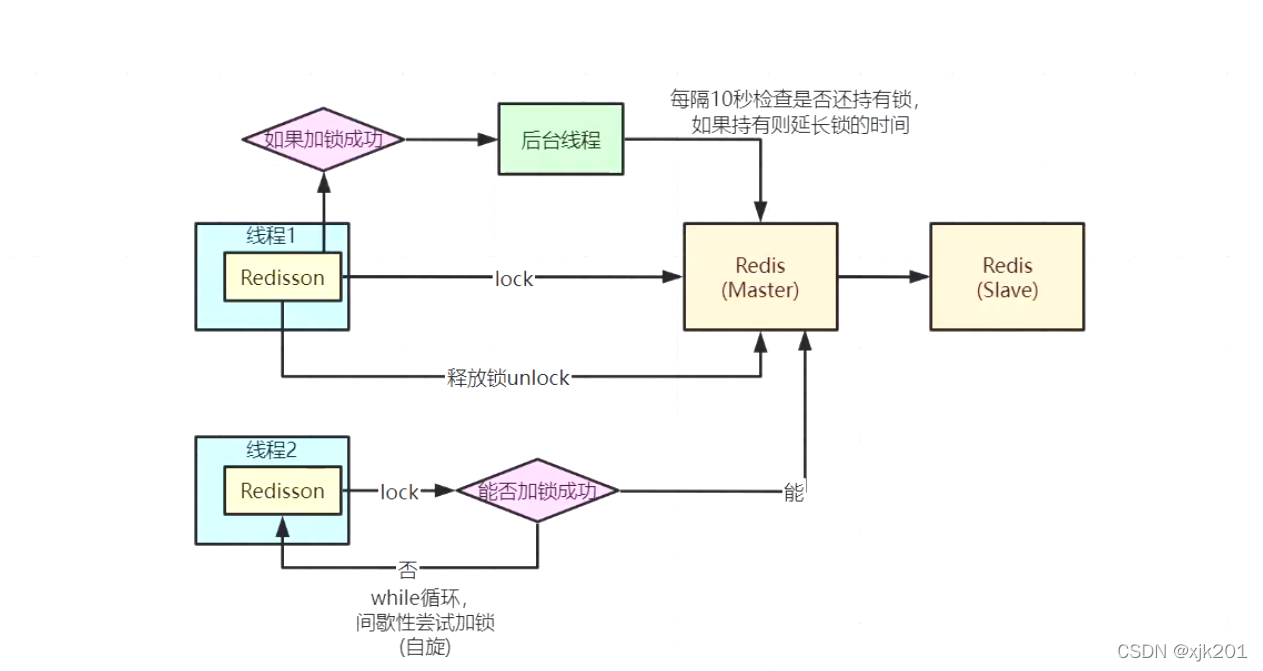
具体实现:
RedissonLock的lock()方法——>lockInterruptibly()->tryAcquire()->tryAcquireAsync(leaseTime, unit, threadId)->tryLockInnerAsync(commandExecutor.getConnectionManager().getCfg().getLockWatchdogTimeout(), TimeUnit.MILLISECONDS, threadId, RedisCommands.EVAL_LONG);
<T> RFuture<T> tryLockInnerAsync(long leaseTime, TimeUnit unit, long threadId, RedisStrictCommand<T> command) {
internalLockLeaseTime = unit.toMillis(leaseTime);
return commandExecutor.evalWriteAsync(getName(), LongCodec.INSTANCE, command,
"if (redis.call('exists', KEYS[1]) == 0) then " +
"redis.call('hset', KEYS[1], ARGV[2], 1); " +
"redis.call('pexpire', KEYS[1], ARGV[1]); " +
"return nil; " +
"end; " +
"if (redis.call('hexists', KEYS[1], ARGV[2]) == 1) then " +
"redis.call('hincrby', KEYS[1], ARGV[2], 1); " +
"redis.call('pexpire', KEYS[1], ARGV[1]); " +
"return nil; " +
"end; " +
"return redis.call('pttl', KEYS[1]);",
Collections.<Object>singletonList(getName()), internalLockLeaseTime, getLockName(threadId));
}上面第一段if的脚本就是先判断锁存不存在,不存在就用hash结构存放并且设置过期时间,
第二个if就是锁存在那么支持可重入,锁增加相应的重入值(hincrby)。
上面连个if都不满足就说明不是当前线程持有锁,就返回当前锁key 的剩余过期时间。
接下来看异步回调的部分:
private void scheduleExpirationRenewal(final long threadId) {
if (expirationRenewalMap.containsKey(getEntryName())) {
return;
}
Timeout task = commandExecutor.getConnectionManager().newTimeout(new TimerTask() {
@Override
public void run(Timeout timeout) throws Exception {
RFuture<Boolean> future = commandExecutor.evalWriteAsync(getName(), LongCodec.INSTANCE, RedisCommands.EVAL_BOOLEAN,
"if (redis.call('hexists', KEYS[1], ARGV[2]) == 1) then " +
"redis.call('pexpire', KEYS[1], ARGV[1]); " +
"return 1; " +
"end; " +
"return 0;",
Collections.<Object>singletonList(getName()), internalLockLeaseTime, getLockName(threadId));
future.addListener(new FutureListener<Boolean>() {
@Override
public void operationComplete(Future<Boolean> future) throws Exception {
expirationRenewalMap.remove(getEntryName());
if (!future.isSuccess()) {
log.error("Can't update lock " + getName() + " expiration", future.cause());
return;
}
if (future.getNow()) {
// reschedule itself
scheduleExpirationRenewal(threadId);
}
}
});
}
}, internalLockLeaseTime / 3, TimeUnit.MILLISECONDS);
if (expirationRenewalMap.putIfAbsent(getEntryName(), task) != null) {
task.cancel();
}
}ttlRemaining是null就是上面lua脚本两个if的情况,加锁成功了,那么调用scheduleExpirationRenewal(threadId);方法给锁按照超时时间的三分之一延长续命,就是比如锁是30秒超时,那么没=每十秒钟调用续命。 这里scheduleExpirationRenewal方法是嵌套调用的。
上面脚本返回0就结束看门狗线程的续命了。也就是不嵌套调用了。
接下来看下RedissonLock的tryLock(long waitTime, long leaseTime, TimeUnit unit)方法
public boolean tryLock(long waitTime, long leaseTime, TimeUnit unit) throws InterruptedException {
long time = unit.toMillis(waitTime);
long current = System.currentTimeMillis();
final long threadId = Thread.currentThread().getId();
Long ttl = tryAcquire(leaseTime, unit, threadId);
// lock acquired
if (ttl == null) {
return true;
}
time -= (System.currentTimeMillis() - current);
if (time <= 0) {
acquireFailed(threadId);
return false;
}
current = System.currentTimeMillis();
final RFuture<RedissonLockEntry> subscribeFuture = subscribe(threadId);
if (!await(subscribeFuture, time, TimeUnit.MILLISECONDS)) {
if (!subscribeFuture.cancel(false)) {
subscribeFuture.addListener(new FutureListener<RedissonLockEntry>() {
@Override
public void operationComplete(Future<RedissonLockEntry> future) throws Exception {
if (subscribeFuture.isSuccess()) {
unsubscribe(subscribeFuture, threadId);
}
}
});
}
acquireFailed(threadId);
return false;
}
try {
time -= (System.currentTimeMillis() - current);
if (time <= 0) {
acquireFailed(threadId);
return false;
}
while (true) {
long currentTime = System.currentTimeMillis();
ttl = tryAcquire(leaseTime, unit, threadId);
// lock acquired
if (ttl == null) {
return true;
}
time -= (System.currentTimeMillis() - currentTime);
if (time <= 0) {
acquireFailed(threadId);
return false;
}
// waiting for message
currentTime = System.currentTimeMillis();
if (ttl >= 0 && ttl < time) {
getEntry(threadId).getLatch().tryAcquire(ttl, TimeUnit.MILLISECONDS);
} else {
getEntry(threadId).getLatch().tryAcquire(time, TimeUnit.MILLISECONDS);
}
time -= (System.currentTimeMillis() - currentTime);
if (time <= 0) {
acquireFailed(threadId);
return false;
}
}
} finally {
unsubscribe(subscribeFuture, threadId);
}
// return get(tryLockAsync(waitTime, leaseTime, unit));
}由前面分析的tryAcquire方法可见,lua脚本返回null说明加锁成功,否则返回锁的剩余时间,
接着final RFuture<RedissonLockEntry> subscribeFuture = subscribe(threadId);使用recis的发布订阅模式,订阅这个锁的channel队列,
然后进入while(true)的循环再次加锁,返回null就和上面说的一样加锁成功,否则
信号量 加锁 : 获取许可 ,等待锁的超时时间结束再获取锁 (ttl)对性能要好,否则一直while(true)的循环性能就太差了
if (ttl >= 0 && ttl < time) {
getEntry(threadId).getLatch().tryAcquire(ttl, TimeUnit.MILLISECONDS);
} else {
getEntry(threadId).getLatch().tryAcquire(time, TimeUnit.MILLISECONDS);
}这里的getlatch是aqs的信号量
public Semaphore getLatch() {
return latch;
}
接下来看解锁方法:
@Override
public void unlock() {
Boolean opStatus = get(unlockInnerAsync(Thread.currentThread().getId()));
if (opStatus == null) {
throw new IllegalMonitorStateException("attempt to unlock lock, not locked by current thread by node id: "
+ id + " thread-id: " + Thread.currentThread().getId());
}
if (opStatus) {
cancelExpirationRenewal();
}
// Future<Void> future = unlockAsync();
// future.awaitUninterruptibly();
// if (future.isSuccess()) {
// return;
// }
// if (future.cause() instanceof IllegalMonitorStateException) {
// throw (IllegalMonitorStateException)future.cause();
// }
// throw commandExecutor.convertException(future);
}
照样是个lua脚本
protected RFuture<Boolean> unlockInnerAsync(long threadId) {
return commandExecutor.evalWriteAsync(getName(), LongCodec.INSTANCE, RedisCommands.EVAL_BOOLEAN,
"if (redis.call('exists', KEYS[1]) == 0) then " +
"redis.call('publish', KEYS[2], ARGV[1]); " +
"return 1; " +
"end;" +
"if (redis.call('hexists', KEYS[1], ARGV[3]) == 0) then " +
"return nil;" +
"end; " +
"local counter = redis.call('hincrby', KEYS[1], ARGV[3], -1); " +
"if (counter > 0) then " +
"redis.call('pexpire', KEYS[1], ARGV[2]); " +
"return 0; " +
"else " +
"redis.call('del', KEYS[1]); " +
"redis.call('publish', KEYS[2], ARGV[1]); " +
"return 1; "+
"end; " +
"return nil;",
Arrays.<Object>asList(getName(), getChannelName()), LockPubSub.unlockMessage, internalLockLeaseTime, getLockName(threadId));
}重点是counter开始的逻辑,local counter = redis.call('hincrby', KEYS[1], ARGV[3], -1); -1就是可重入数量减1。如果count大于0及说明是重入锁,只有count等于0才是说明解锁成功,那么发布通知那些订阅这个锁的线程,并且删除这个key。
发布订阅在LockPubSub这个类里面:
回调的方法:
protected void onMessage(RedissonLockEntry value, Long message) {
if (message.equals(unlockMessage)) {
value.getLatch().release();
while (true) {
Runnable runnableToExecute = null;
synchronized (value) {
Runnable runnable = value.getListeners().poll();
if (runnable != null) {
if (value.getLatch().tryAcquire()) {
runnableToExecute = runnable;
} else {
value.addListener(runnable);
}
}
}
if (runnableToExecute != null) {
runnableToExecute.run();
} else {
return;
}
}
}
}
这里就有尝试加锁的逻辑tryAcquire
可重入分布式锁:
这里重点还是lua脚本有区别
RedissonReadLock:
@Override
<T> RFuture<T> tryLockInnerAsync(long leaseTime, TimeUnit unit, long threadId, RedisStrictCommand<T> command) {
internalLockLeaseTime = unit.toMillis(leaseTime);
return commandExecutor.evalWriteAsync(getName(), LongCodec.INSTANCE, command,
"local mode = redis.call('hget', KEYS[1], 'mode'); " +
"if (mode == false) then " +
"redis.call('hset', KEYS[1], 'mode', 'read'); " +
"redis.call('hset', KEYS[1], ARGV[2], 1); " +
"redis.call('set', KEYS[2] .. ':1', 1); " +
"redis.call('pexpire', KEYS[2] .. ':1', ARGV[1]); " +
"redis.call('pexpire', KEYS[1], ARGV[1]); " +
"return nil; " +
"end; " +
"if (mode == 'read') or (mode == 'write' and redis.call('hexists', KEYS[1], ARGV[3]) == 1) then " +
"local ind = redis.call('hincrby', KEYS[1], ARGV[2], 1); " +
"local key = KEYS[2] .. ':' .. ind;" +
"redis.call('set', key, 1); " +
"redis.call('pexpire', key, ARGV[1]); " +
"redis.call('pexpire', KEYS[1], ARGV[1]); " +
"return nil; " +
"end;" +
"return redis.call('pttl', KEYS[1]);",
Arrays.<Object>asList(getName(), getReadWriteTimeoutNamePrefix(threadId)),
internalLockLeaseTime, getLockName(threadId), getWriteLockName(threadId));
}
这里用hash的mode字段,read表示读锁,write表示写锁。
第一个if表示加了读锁,设置过期时间
第二个if就是可重入锁的逻辑,不管之前是读还是写都将其 +1
同样解锁也有publish发布通知订阅这个key的线程这些操作,可重入count数量减少这些操作
写锁:
@Override
<T> RFuture<T> tryLockInnerAsync(long leaseTime, TimeUnit unit, long threadId, RedisStrictCommand<T> command) {
internalLockLeaseTime = unit.toMillis(leaseTime);
return commandExecutor.evalWriteAsync(getName(), LongCodec.INSTANCE, command,
"local mode = redis.call('hget', KEYS[1], 'mode'); " +
"if (mode == false) then " +
"redis.call('hset', KEYS[1], 'mode', 'write'); " +
"redis.call('hset', KEYS[1], ARGV[2], 1); " +
"redis.call('pexpire', KEYS[1], ARGV[1]); " +
"return nil; " +
"end; " +
"if (mode == 'write') then " +
"if (redis.call('hexists', KEYS[1], ARGV[2]) == 1) then " +
"redis.call('hincrby', KEYS[1], ARGV[2], 1); " +
"local currentExpire = redis.call('pttl', KEYS[1]); " +
"redis.call('pexpire', KEYS[1], currentExpire + ARGV[1]); " +
"return nil; " +
"end; " +
"end;" +
"return redis.call('pttl', KEYS[1]);",
Arrays.<Object>asList(getName()),
internalLockLeaseTime, getLockName(threadId));
}
同样的 第一个if是加锁逻辑,第二个if是重入逻辑。
RedLock:
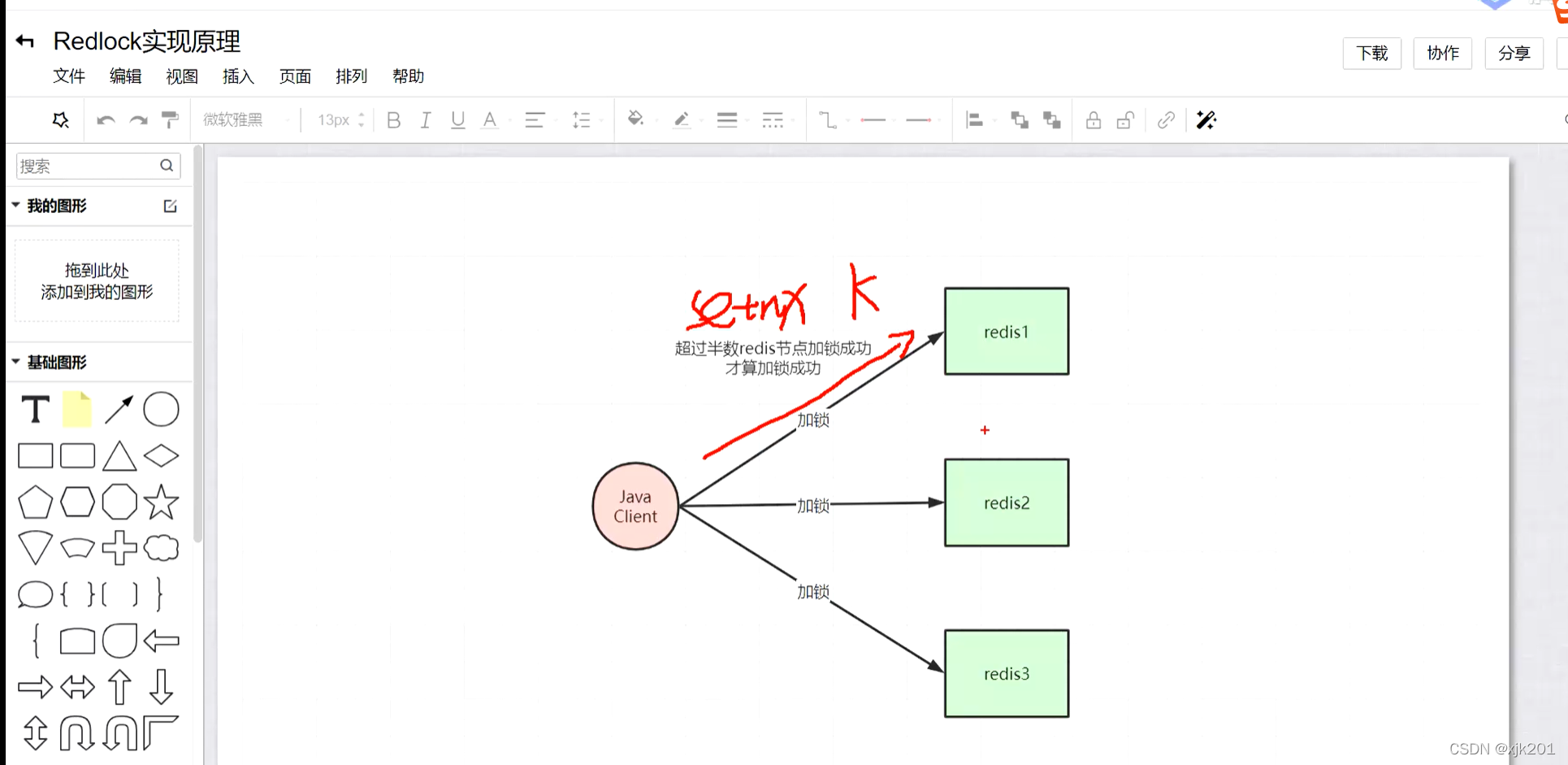
保证高可用 都拖一个从节点,免得挂两个出现永远加锁不成功 如下图所示:
底层每个节点都去setnx ,至少半数以上节点返回成功才认为成功
红锁不推荐用: 针对同一个key的锁而言
客户端1 redis1加锁成功,redis2加锁成功,然后redis2返回成功后挂掉了
客户端2 来redis3加锁成功 ,新的redis2从节点顶上来加锁成功 ,那么客户端1和客户端2都加锁成功了,就有问题了
redis的持久化 假设1s一次 ,那么redis2 也就是节点2 就这一秒钟 加锁的时候key 挂掉了或者重启了 ,那就坑了,这个key就丢掉了,然后别的客户端再来加锁就出现上面的问题

因为 redis 就是 ap 保证高性能,所以这样的话要不就用zk算了
说白了分布式锁就是把并行的请求串行化了
又要分布式锁,又要高并发,那就得根据各种场景优化了。
锁的粒度 越小越好
redis里面多分几个key 初始化时候拆成十个key , 写热点分散
这样就性能提升了十倍,减完key的段位就加标记
就和cmap底层差不多
分布式锁可以解决双写不一致问题
大部分 都是 冷门数据 ,九成 热点商品大部分请求 下面 的第一个if直接返回,很少的请求 完整走一次后端 , 大部分代码都是解决小部分问题, 下面if红线的小部分代码解决九成情况。
比如 并发重建线程有几万这在下图箭头这边
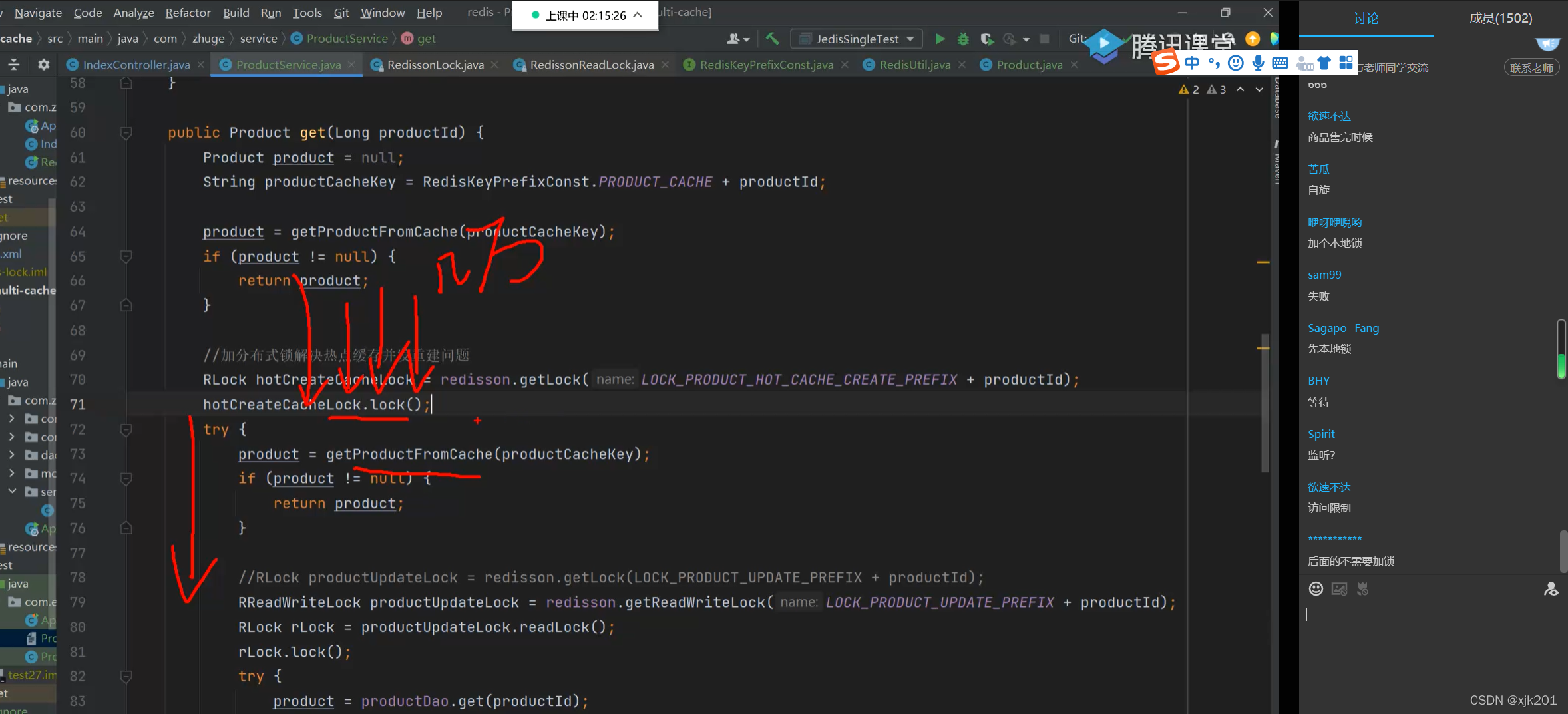
预估知道逻辑 1秒能执行完 ,就直接 串行转并发 设置1秒钟的trylock 然后直接读取下面的缓存 99.99场景 0.001情况出bug 所以用不用需要结合具体的业务场景
说白了架构就是结合具体业务场景的取舍

热点缓存监控系统:
所有 web应用 监听 热点缓存(去实时计算热点 对 redis 操作做aop拦截 然后往热点缓存系统里面发送请求 分布式大规模数据实时计算来维护这个热点缓存的)
热点缓存通知 web应用去更新
不可能说是redis的key修改,web应用去通知别的web应用更新,这样成本太大了。




 本文深入探讨了Redis中实现分布式锁的方法,包括Redisson库的使用,强调了原子性操作的重要性,以及如何通过锁续命解决线程安全性问题。还讨论了RedLock的高可用性挑战,并提到了锁的粒度优化和分布式锁在解决并发问题中的作用。此外,文章提及了热点缓存监控系统和分布式锁在业务场景中的应用策略。
本文深入探讨了Redis中实现分布式锁的方法,包括Redisson库的使用,强调了原子性操作的重要性,以及如何通过锁续命解决线程安全性问题。还讨论了RedLock的高可用性挑战,并提到了锁的粒度优化和分布式锁在解决并发问题中的作用。此外,文章提及了热点缓存监控系统和分布式锁在业务场景中的应用策略。
















 1416
1416

 被折叠的 条评论
为什么被折叠?
被折叠的 条评论
为什么被折叠?








